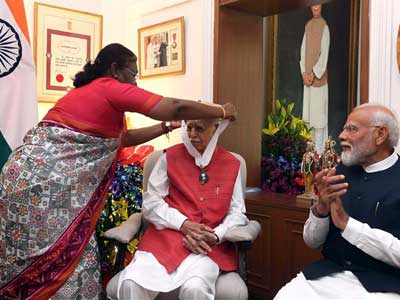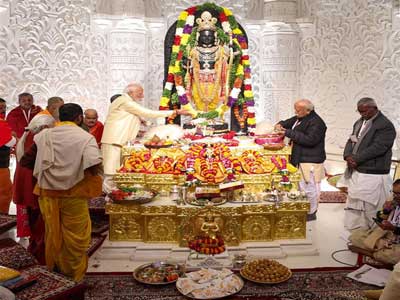In the neighbourhood of two world heritage monuments, the Taj Mahal and the Red Fort, Agra’s famous Vaidya Gali has been a favourite of kings, politicians and the common man for over a century and more, but these days the number of patrons has dwindled, as allopathy has come to dominate the health sector.
Agra, a city steeped in rich cultural heritage, Ayurveda has deep historical roots, particularly evident in the once-busy Vaidya Gali near Agra Fort. Once a bustling hub for Ayurvedic practitioners and traditional medicines, Vaidya Gali now wears a deserted look, reflecting a shift in focus towards allopathy and modern healthcare practices.
हिंदी में पढ़ें : धन्वंतरि जयंती पर अब वीरान नजर आती है आगरा की प्रसिद्ध वैद्य गली
“Nowhere in India, even in Kerala, is there an exclusive market of Vaidyas practising Ayurveda, but in Agra several generations of well-known Vaidyas have had their shops or what may now be called clinics in one single lane, in the Rawat Pada area close to Agra Fort,” recalls an old timer.
Once upon a time, people from long distances made a beeline in the narrow lane since early morning, for consultation with one of the dozens of Vaidyas, all coming from a single clan. “You could hear sounds from the pounding of herbs or smell aromas from a distance,” Mukul bhai adds.
On Dhan Teras, also known as Dhanvantari Divas, the area wore a festival look as special pujas were held for Dhanvantri, the god of medicine. But today, the once busy Vaidya Gali has transformed into a wholesale market for consumer goods. The younger generation of Vaidyas from the area has left for greener pastures. Many of them have taken to practising allopathy.
"Nowhere in India could you find so many famous and popular Vaidyas practising ayurveda with dedication and strict adherence to the norms of the medical practice that were handed down across generations," Kaushal Narayan Sharma, great-great-grandson of the famous Vaidya Ram Dutt Sharma, said.
Even Mahatma Gandhi once stayed in Agra in 1929, for 11 days, while under the treatment of a local Vaidya. The house he lived in while under treatment is now the Gandhi Smarak adjacent to the Etmauddaula Tomb.
"My father told me that Gandhiji once had some infection. In Agra, he received mud and water treatment by a famous Vaidya," a priest of a famous Temple in the Rawat Pada area said.
"We still have a few Vaidyas in the area. The Kshetra Bajaja Samiti also runs an ayurvedic dispensary. The Rawat Pada area, known as the spices mandi, also has numerous retail counters selling ayurvedic drugs, herbal concoctions, roots and skins, powders and 'bhasm'. The demand has picked up after Baba Ramdev's Patanjali launched ayurvedic preparations in modern packaging, say the shopkeepers.
While Kerala in south India has emerged as an important destination for Ayurvedic treatment, there are old-timers here who say that Agra Vaidyas, though more knowledgeable and popular, failed to change with time and could not market their skills and products, resulting in the loss of clientele.
Till 2000, there used to be around 20 Vaidyas, but now the number has come down to just four. Interestingly, the names of all Vaidyas had the suffix Ram with their names, like Ram Bhushan, Ram Dutt, Ram Dinesh, Ram Adhaar, Ram Dhun, Ram Murti, etc. However, in 1937, Agra's first X-ray unit was set up by Dr Ram Narayan, whose family now takes the name Narayan instead of Ram.
Though the extended family of these Vaidyas owns more than 40 havelis and mansions in the heart of the city, around the famous Mankameshwar Temple, the traditional profession of 'vaidya-giri' no longer attracts the younger generation. "A heritage is on the verge of extinction," lamented Rajiv Gupta, president of Lok Swar.
Alternative therapies, particularly Ayurveda, have gained significant attention as spaces for holistic healing in modern health discussions. Ayurveda, a traditional Indian system of medicine, emphasises balance between body, mind, and spirit, leveraging natural remedies and lifestyle practices for wellness.
Revitalising such traditional spaces is crucial for preserving Agra's medicinal history while promoting the benefits of Ayurveda. Community awareness campaigns, workshops, and integration of Ayurveda into contemporary wellness programs can rekindle interest, enabling locals and visitors to explore these time-honoured healing practices, thus fostering a blend of tradition and modern health consciousness.


















Related Items
Mobile clinics boost health outcomes, cut costs in developing countries
Private sector has become the beating engine of India’s economy
People eat less meat to benefit their own health, not for environment